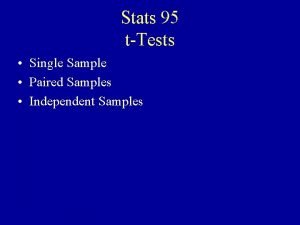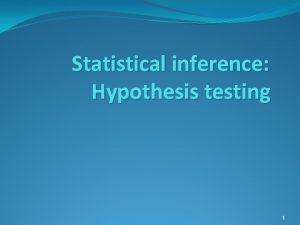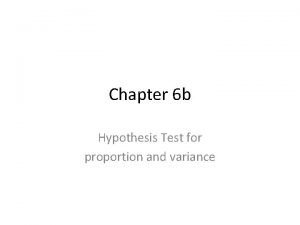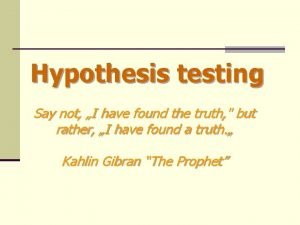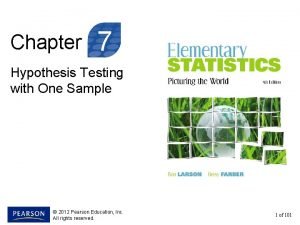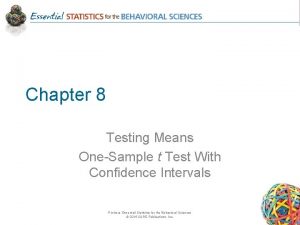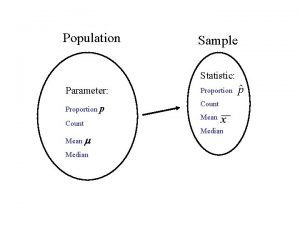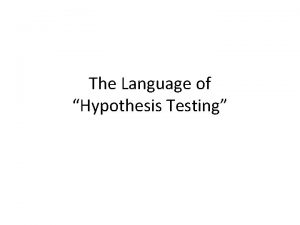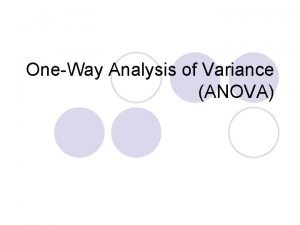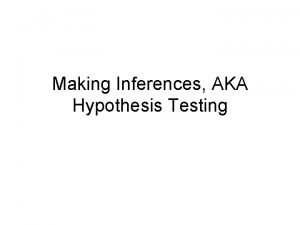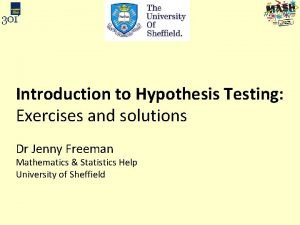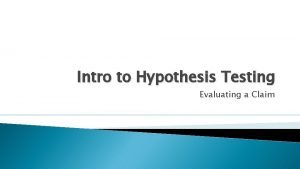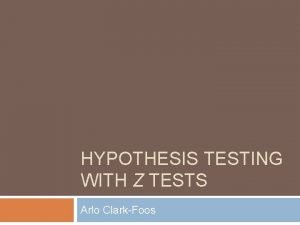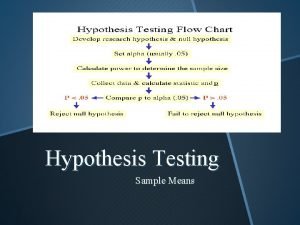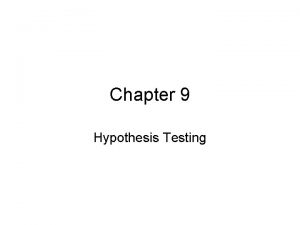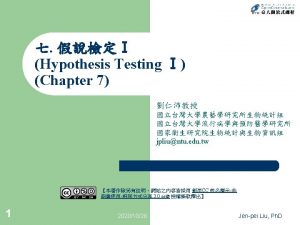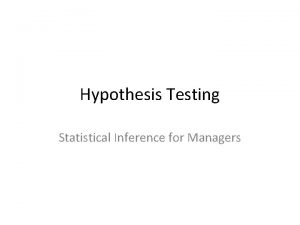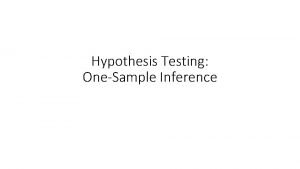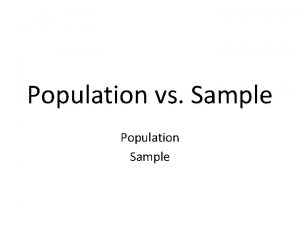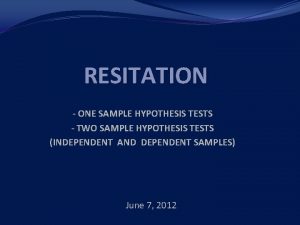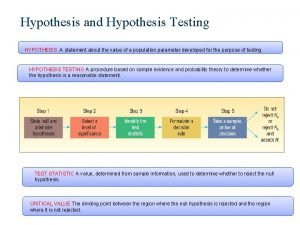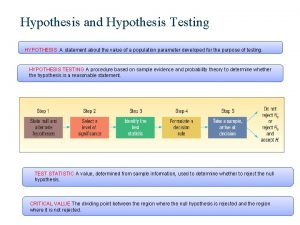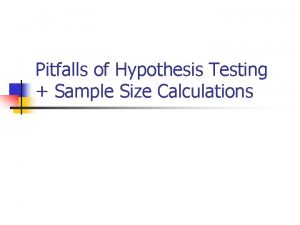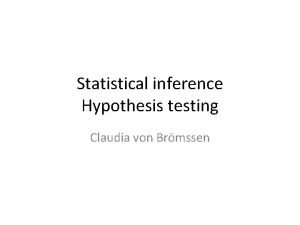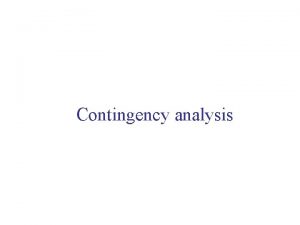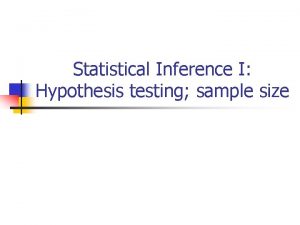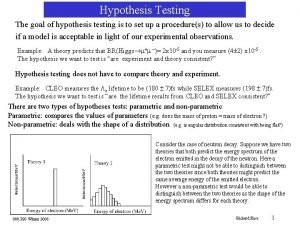Inference Concepts Hypothesis Testing Inference Sample Statistic Population




















- Slides: 20

Inference Concepts Hypothesis Testing

Inference Sample Statistic Population Parameter • Hypothesis/Significance Testing – assess evidence the data gives against a hypothesis about a parameter • Confidence Regions – provide a range (region) believed to contain the parameter with a certain believability (confidence) Confidence Intervals Slide #2

The Scientific Method Make Observation Construct Hypothesis Make Predictions from Hypothesis Gather Observations / Experiment Compare Observations to Predictions Match, gain belief in hypothesis Don’t match, lose belief in hypothesis Inference Concepts Slide #3

The Scientific Method Statistical hypothesis testing. Construct is at center Make Observation Hypothesis Compares predictions to observations in the face of. Make sampling variability Predictions from Hypothesis Statistical hypothesis testing follows same logic Gather Observations / Experiment Compares observations to predictions from a hypothesis Compare Observations to Predictions Match, gain belief in hypothesis Don’t match, lose belief in hypothesis Inference Concepts Slide #4

Two Main Hypothesis Types • Research Hypothesis – a general statement of an effect • Statistical Hypothesis (two types) – Alternative Hypotheses (HA) • a mathematical representation of the research hypothesis • one of HA: parameter <, >, specific value – Null Hypotheses (Ho) • the “no effect” or “no difference” situation • always Ho: parameter = specific value Inference Concepts Slide #5

What is the null and alternative hypotheses for these research hypotheses … • “The mean density of Canada yew (Taxus canadensis) in areas not exposed to moose (Alces alces) on Isle Royale will be more than 1 stem per m 2” • “The mean age of medical college students (Homo sapien) is less than 24 years” • “The mean number of murders per burrough is less than 90” • “The mean longevity of employees at the company is different than 10 years” Inference Concepts Slide #6

An Example • A research paper claims that the mean fetal heart rate is 137 bpm. A doctor feels that the mean rate is lower for women admitted to her clinic. What are the statistical hypotheses? HA: m < 137 HO: m = 137 • She will test her belief with … – a random sample of 100 patients – assuming s =10 Inference Concepts Slide #7

The Null Hypothesis • Assumed, initially, to be true – Used to predict what will be observed in a sample • Thus, if H 0: m=137 then one predicts that`x=137 • IF there was no sampling variability, then what do you think about H 0 if`x=135 is observed Inference Concepts Slide #8

Sampling Variability 137 Assume H 0 is true SE – measure of sampling variability 136 137 138 139 140 134 135 Does 134 support H 0? Does 136. 5 support H 0? Does 135 support H 0? Inference Concepts Slide #9

Objectivity – p-value • PR(observed statistic or value more extreme assuming H 0 is true) One-Tailed – shade to left if a “less than” HA Two-Tailed – shade to right if a “greater than” HA – shade into both tails if a “not equals” HA Inference Concepts Slide #10

An Example 137 HA: m < 137 Suppose`x=135. 9 was observed p-value = Pr(`x=135. 9 or less, if m=137 ) distrib(135. 9, mean=137, sd=1) p-value = 0. 1357 134 135 136 135. 9 137 138 139 Inference Concepts 140 Slide #11

Objectivity – p-value • PR(observed statistic or value more extreme assuming H 0 is true) • Compare to rejection criterion – a – if p-value < a then reject H 0 – if p-value > a then Do Not Reject (DNR) H 0 Critical • Rejection criterion (a) – “sets” cut-off value for determining support of H 0 – Set by researcher a priori – typical values are 0. 10, 0. 05, 0. 01 Inference Concepts Slide #12

An Example • The doctor set a at 0. 05 135. 9 137 • The p-value of 0. 1357 is greater than a – Thus, DNR H 0 – Conclude that mean fetal heart rate for all of her patients is not less than 137 bpm • The`x of 135. 9 likely occurred because of sampling variability and not a real difference from 137 bpm Inference Concepts Slide #13

For each situation below, write a definition of the pvalue, compute the p-value, and make a decision – HA: m<80, s=40, n=50, `x=74, a=0. 05 – HA: m>100, s=20, n=40, `x=105, a=0. 05 – HA: m>100, s=20, n=80, `x=105, a=0. 05 – HA: m≠ 100, s=20, n=60, `x=103, a=0. 10 – HA: m<100, s=20, n=40, `x=96, a=0. 01 Inference Concepts Slide #14

Summary • Make statistical hypotheses from research hypothesis • Use H 0 to make prediction (Assume H 0 is true) – this is why H 0 must be the “equals” situation • Compare predicted statistic to observed statistic – calculate p-value • Compare p-value to rejection criterion (a) – if p-value > a then DNR H 0 • conclude that H 0 could be correct Critical – if p-value < a then reject H 0 • conclude that H 0 is probably not correct Inference Concepts Slide #15

if p-value > a then H 0 could be correct • Recall that `x = 135. 9 • for H 0: m=137, p-value=0. 1357, DNR H 0 distrib(135. 9, mean=137, sd=1) • for H 0: m=137. 1, p-value=0. 1151, DNR H 0 distrib(135. 9, mean=137. 1, sd=1) • for H 0: m=137. 2, p-value=0. 0968, DNR H 0 distrib(135. 9, mean=137. 2, sd=1) • for H 0: m=137. 3, p-value=0. 0808, DNR H 0 distrib(135. 9, mean=137. 3, sd=1) • There always several other hypotheses that would also not be rejected. Inference Concepts Slide #16

DNR vs Accept • The data do not contradict this H 0, but it is not fully known if this H 0 is true. Inference Concepts Slide #17

if p-value < a then H 0 is probably incorrect Even if H 0 is truly correct it is possible to observe a statistic in the tail, resulting in a p-value < a, and a rejection of H 0. 134 135 136 137 138 139 140 Inference Concepts Slide #18

Decision Making Errors Set a priori by the researcher Can’t be known, because truth is not known Type I a Correct power Correct Type II b Inference Concepts Slide #19

Effects on b • b is inversely related to a – i. e. , “trading errors” • b is inversely related to n – i. e. , “more information means fewer errors” • b is inversely related to difference between true and hypothesized value of parameter – i. e. , “more obvious difference means fewer errors” Inference Concepts Slide #20
 Paired t test vs unpaired
Paired t test vs unpaired P-value interpretation
P-value interpretation Hypothesis testing for population proportion
Hypothesis testing for population proportion Hypothesis testing for variance
Hypothesis testing for variance Chapter 7 hypothesis testing with one sample answers
Chapter 7 hypothesis testing with one sample answers Effect size for t test
Effect size for t test Population proportion standard deviation
Population proportion standard deviation Hypothesis examples in research
Hypothesis examples in research Null and alternative hypothesis statistics
Null and alternative hypothesis statistics Null hypothesis example
Null hypothesis example Weakness of protoplanet hypothesis
Weakness of protoplanet hypothesis Population ecology section 1 population dynamics answer key
Population ecology section 1 population dynamics answer key Population ecology section 1 population dynamics answer key
Population ecology section 1 population dynamics answer key Population ecology section 1 population dynamics
Population ecology section 1 population dynamics Chapter 4 section 1: population dynamics
Chapter 4 section 1: population dynamics The language of hypothesis testing
The language of hypothesis testing Gabriel welsch
Gabriel welsch Hypothesis testing assignment
Hypothesis testing assignment Hypothesis testing
Hypothesis testing Critical value hypothesis testing
Critical value hypothesis testing Assumptions of hypothesis testing
Assumptions of hypothesis testing
